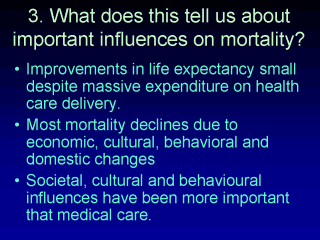| front |1 |2 |3 |4 |5 |6 |7 |8 |9 |10 |11 |12 |13 |14 |15 |16 |17 |18 |19 |20 |21 |22 |23 |24 |25 |26 |27 |28 |29 |30 |31 |32 |33 |34 |35 |36 |37 |38 |review |
 |
Well, what can we
conclude from the data you have seen so far? 1. Despite the massive expenditure of health services delivery since WWII, the improvements in life expectancy have been meager and far short of what might be expected from the trillions of US$ spent. 2. Most of the declines in mortality from the mid 19th to the mid 20th Centuries were due to societal, cultural, behavioural, educational and domestic changes, many of which were driven by legislation. 3. Changes in the way people live their lives prove to be far more effective in changing mortality rates than does better and more expensive medical technology. Sometimes these changes can be as simple as providing education for girls, changing food preparation or making condoms available for family planning. |